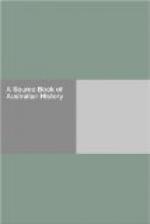+Source.+—Life of Charles Sturt (Mrs. N.G. Sturt), pp. 230-232, 264-267, 279-280
Observations of the migrations of birds convinced Sturt that there was good land in the interior of New South Wales, and in 1844 he set out to find it. His expedition failed because the season was exceptionally dry, and he was obliged to turn back before he had accomplished his object.
“If a line be drawn from Lat. 29 deg. 30’ and Long. 140 deg. N.W., and another from Mount Arden due north, they will meet a little to the northward of the tropic, and there I will be bound to say a fine country will be discovered.” On what date Sturt pledges himself to the discovery of this fine country is not stated, but when later regretting his failure to reach the tropic and to set at rest his hypothesis of the better country to be found there, he briefly tells his reason for the supposition.
“Birds observed east of the Darling in the summer of 1828 in about lat. 29 deg. 30’ S. and long. 144 deg. had invariably migrated to the W.N.W. Cockatoos and parrots, known while in the colony to frequent the richest and best-watered valleys of the higher lands, would pass in countless flights to that point of the compass. In South Australia, in lat. 35 deg. and long. 138 deg., I had also observed that several birds of the same kind annually visited that Province from the north. I had seen the Psittacus Novae Hollandiae and the shell paroquet following the shoreline of St. Vincent’s Gulf like flights of starlings in England. The different flights at intervals of more than a quarter of an hour, all came from the north, and followed in one and the same direction.
“Now although the casual appearance of a few strange birds should not influence the judgement, yet from the regular migrations of the feathered race, a reasonable inference may be drawn. Seeing then that these two lines (viz., from Fort Bourke about lat. 30 deg. and long. 144 deg. to the W.N.W., and from Mount Arden in lat. 35 deg. long. 138 deg. to the north) if prolonged would meet a little to the northward of the tropic, I formed the following conclusions:
“First, that the birds migrating on those lines would rest for a time at a point where those lines met.
“Secondly, that the country to which they went would resemble that which they had left, that birds which frequented rich valleys or high hills would not settle down in deserts and flat country.
“Thirdly, that the intervening country, whether owing to deserts or large sheets of water, was not such as these birds could inhabit. Indeed, such large migrations from different parts to one particular, argued no less strongly the existence of deserts or of sea to a certain distance, than the probable richness of the country, to which as to a common goal these migrations tended.




